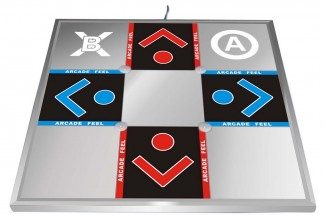Ever wondered if Dance Dance Revolution would work in VR? Ever wondered why anyone would even try? Well, developer Corey Drake did it and we wanted to know why and how, so we asked him.
Dance Dance Revolution from Konami was, in essence, the father of the rhythm-action craze which swept video game arcades in the 90s, spawning frighteningly accomplished players and even gaming tournaments which endured long after the original game’s release. That craze then quickly spread to home gaming with ‘dance mats’, peripherals which captured the position of your feet as you danced, seemingly appearing everywhere.
Now, developer Corey Drake has hacked together a virtual reality demo he calls Oculus Oculus Revolution, inspired by DDR using Unity an Oculus Rift DK2 and an old Genesis dance pad. “At work, we have an event every couple of months where we are given a theme and build a prototype with the timeline of about two or three weeks on our off time for fun and practice,” Drake says, “My prototypes are usually pretty silly and involve some kind of hardware. In the past I’ve used a lot of Arduino (through Uniduino), RFID, 3D printing, augmented reality, etc. The theme this time was music and I happened to have my DDR pads handy. It has outputs for both USB and PS/2 so it seemed like an appropriate and simple hardware to integrate.”

Strapping together ancient gaming and cutting edge VR tech wasn’t straightforward however. “Having not used the pads for years, I quickly found out they do not load the plug and play drivers on my Windows 8 rig. It was recognized fine on my mac, but I opted not to transfer my pro license and reconfigure the Oculus there. Instead, I happened to get it mostly working by using an old ps2-to-usb converter that has been in my truck for about 5 years. (sometimes hoarding is worth it…)” Drake tells us. “This worked except for one problem. The arrows were recognized as axes instead of buttons meaning that pressing both left and right would result in a value of neither. I even found some obscure forum posts that mentioned a button combination that changes the mode but no dice. I ran out of time to troubleshoot and ended up making steps that simply didn’t have doubles.”
With the retro portion of the project handled, implementing the technical portion of VR support was comparatively easy. “With Unity it’s just drag and drop, set some settings and play. I’ve done a handful of Oculus Rift projects and have never had too many troubles,” Drake says.
However, playability and gameplay was a different manner. “A lot of my expectations about this demo were incorrect. The first was that the headset would fly off my head. Really good ddr players have a more efficient play style than I do. I bounce around a lot. I planned to reinforce the headset with a chin strap but it held pretty steady.
My second assumption was that I would get very disoriented. Granted, the first couple play-throughs took some getting used to but after about my third practice it felt quite natural. There was little latency and the pad has a metal bar to hang on to so I didn’t lose my footing. It did however get very sweaty. I tell people it’s just a very expensive sweatband. Finally, it turned out the available slack on the wires was a bit limiting. They are long enough for my more conventional projects but when I got it all set up at work it was a bit of a challenge to keep hardware where I needed it without danger of tripping on cords.”
So, with this project out of the way, what’s next for Corey Drake? “Moving forward I think the next step should be adding a Rock Band guitar and/or microphone.” Drake says and concludes “You can never have too many peripherals.”






